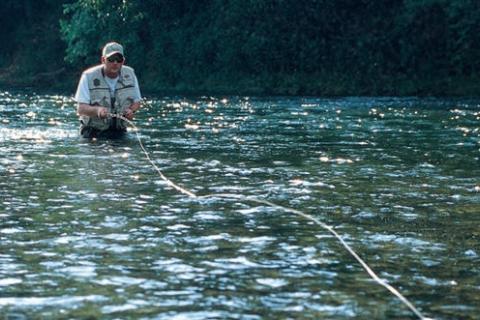
Many fly tiers won’t skimp when it comes to purchasing fly tying materials such as hackles or dubbing for fly tying but never pay any thought to the thread they’ll be using. Other than the hook, fly tying thread is the most important item used in flies because it is what holds all the materials in place.
 |
| Next time you’re shopping for fly tying thread, take a moment to consider thread type, size and whether single-strand or multi-strand is best. |
Single-Strand Threads Versus Multi-Strand Threads
Both of these types of threads have advantages when it comes to tying, but overall, single-strand threads are easier to use especially for the novice tier. While multi-strand thread generally lies flatter on the hook shank (smoother appearance) than single-strand thread, the fraying or breaking strength of this fiber makes it harder to work with. As you wrap multi-strand threads, they can fray (by hitting the hook point or having too much pressure) or separate causing the person tying to go back and correct the wraps. You can spin this thread to keep it tight but it is another chore that the tier has to remember.
Tread Materials
Three basic thread types dominate the fly tying market. Nylon, Polyester and Kevlar are the most used threads by today’s tiers. Silk or newer gel spun polyethylene (GSP) is also available if one looks hard enough. Nylon and polyester are cheap, thin and strong, making them ideal for tiers. Nylon threads in comparison to polyester have more stretch making them easier to work with. Kevlar threads are super tough with very little stretch. While Kevlar can be a bit of a bear to work with, it has its uses when it comes to large flies, synthetic materials or spinning hair.
When thinking about the many different sizes of threads, tiers generally lean towards using the smallest diameter of thread they are comfortable with. The smaller the thread, the less bulk there is on the fly as you wrap down materials. The one exception to this rule is when tiers are creating large patterns and need a very strong thread to spin/flare hair or cinch synthetics in place tightly. Below is a table of the basic thread sizes and their general uses.
![]() Click here to see a larger veiw of the Fly Fishing Thread Sizes and Description chart.
Click here to see a larger veiw of the Fly Fishing Thread Sizes and Description chart.

Wax Versus Non-Waxed
Tying thread is available in either waxed or non-waxed varieties. The waxed threads will be a bit easier to work with when wrapping down unruly materials (the wax sticks to materials holding them in place until pressure is applied locking them down) and these threads can be dubbed without special preparation. Non-waxed threads are cleaner (they don’t pick up dirt and debris from your tying station) have less bulk, and take up glues better. You can always spot wax a part of your thread by hand if you need to dub a section for a fly body.
Take some time to practice with different thread sizes and types to find out what works for you and the pattern you are tying. Remember, like hooks, good thread is not something to skimp on. Having the right materials in your fly tying kit will help you avoid frustration and make for a more enjoyable fly tying experience.
Deer hair is another important element for fly tying. Learn how to pick the best deer hair for your fly fishing creations at Bass Pro Shops 1Source.
- 16925 views

